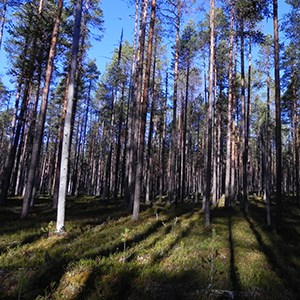SLU receives major grants for forest research

The Knut and Alice Wallenberg Foundation invests SEK 100 million over a ten-year period for research within forest production and forest management at the Swedish University of Agricultural Sciences (SLU), and SEK 180 million for research on tree genes, forest biotechnology and forest genetics at SLU, Umeå University, Uppsala University and Science For Life Laboratory.
The long term goal of the research is to develop new efficient methods to increase the production of forest raw materials in a sustainable manner. This is an important foundation for the transition from an oil and coal-based economy to a future sustainable bio-based, carbon dioxide-neutral economy.
"The Knut and Alice Wallenberg Foundation has already made major and important investments in forest biotechnology and forest genomics that allowed SLU and Sweden to have a leading position in these areas. It is very encouraging that the Foundation in this way recognizes the importance of forest research at SLU and allows us to build on and develop this research for the future. This is a further acknowledgement of our excellent forest research and its importance for a sustainable future", says Karin Holmgren, Vice-Chancellor of SLU.
The project in forest production and forest management, is coordinated by Professor Tomas Lundmark, SLU, and the project on tree genes, forest biotechnology and forest genetics is coordinated by Professor Ove Nilsson at SLU and Professor Ulf Gyllensten at Uppsala University.
"These new initiatives will allow a comprehensive integration of basic research that intends to understand the underlying conditions for forest growth from a genetic, physiological and forest-based perspective", declare the professors Ove Nilsson and Tomas Lundmark.
The research project on tree genes and forest biotechnology aims to identify new genes that control growth and wood formation in trees. Part of this project is based on a fully automated phenotyping platform at the Umeå Plant Science Centre (UPSC), a research centre that belongs to SLU and Umeå University. Hundreds of trees can be grown on conveyor belts at this platform and their growth and other properties are automatically measured. This platform is so far unique for dedicated tree research.
The part of the project that is focused on genomics and forest genetics follows up on the large project that led to the first mapping of a conifer tree genome, the Norway spruce genome. That previous project was also funded by the Knut and Alice Wallenberg Foundation and was as well a collaboration between SLU, Umeå University and Science for Life Laboratory. In the new project, an updated and significantly improved version of the spruce genome will be developed. In parallel, the genome of Scots pine will be sequenced.
Moreover, genetic variations in the genomes of thousands of spruce and pine trees that are linked to the Swedish coniferous breeding programs will be analysed. This will provide important basic research tools to understand the trees' natural variation and allow the development of new efficient tools for tree breeding, so-called genomic selection. This part of the project takes place in close collaboration with the the Forestry Research Institute of Sweden (Skogforsk).
The forest management project will ensure that the entire potential of the genetics project and the latest breakthroughs in plant nutrition research are further exploited and developed. With the support of new digital technology, forest growth will be enhanced by increasing the diversity in forestry. The idea is to combine the right plant with the right forest management action at the right place to get the best growth-enhancing effect.
Forest management programs will be developed by utilizing the latest basic research on how tree growth is affected by ecophysiological factors such as nutrition and water, how trees collaborate with fungi and microorganisms and on the effect of tree competition, not least under the ground. The aim is to at least double the growth increase that is reached today. With enlarged availability of renewable forest raw materials, the forest can further contribute to the growing bioeconomy and mitigate the effects of climate change.
Contact persons
Professor Ove Nilsson
Department of Forest Genetics and Plant Physiology
Swedish University of Agricultural Sciences
ove.nilsson@slu.se, +46 (0)70 286 90 82
https://www.upsc.se/researchers/4643-control-of-flowering-time-and-meristem-identity-ove-nilsson.html
Professor Tomas Lundmark
Department of Forest Ecology and Management
Swedish University of Agricultural Sciences
tomas.lundmark@slu.se,+46 (0)70 631 74 12
Press images
(May be published without charge in articles about this press release, please acknowledge the source)
Scots pine forest. Photo: Sonali Ranade
Ove Nilsson. Photo: Julio Gonzalez, SLU
Tomas Lundmark. Photo: Julio Gonzalez, SLU